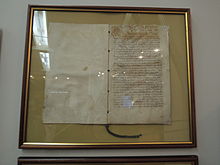|
Ingrian War
The Ingrian War (Swedish: Ingermanländska kriget) was a conflict fought between the Swedish Empire and the Tsardom of Russia which lasted between 1610 and 1617. It can be seen as part of Russia's Time of Troubles,[1] and is mainly remembered for the attempt to put a Swedish duke on the Russian throne. It ended with a large Swedish territorial gain (including Ingria) in the Treaty of Stolbovo, which laid an important foundation to Sweden's Age of Greatness.[2] PreludeDuring Russia's Time of Troubles, Vasily IV of Russia was besieged in Moscow by the supporters of the False Dmitry II. Driven to despair by the Polish intervention, he entered into an alliance with Charles IX of Sweden, who was also waging war against Poland. According to the Vyborg Treatise of 1609, the tsar promised to cede Korela Fortress to Sweden in recompense for military support against False Dmitry II and the Poles.[3][4] Russia also renounced all territorial claims on the coast of the Baltic Sea coast.[4] The Swedish commander Jacob De la Gardie joined his forces with the Russian commander Mikhail Skopin-Shuisky and marched from Novgorod towards Moscow in order to relieve the tsar.[5] In May, the De la Gardie campaign began, where the Swedish corps fought as part of the army of Skopin-Shuisky, who managed to clear a significant part of Russia from the interventionists.[5] Sweden's involvement in Russian affairs gave King Sigismund III Vasa of Poland a pretext to declare war on Russia. After the sudden death of Skopin-Shuisky, De la Gardie's troops were united with Shuisky's army, and the Poles defeated the combined Russo-Swedish force at the Battle of Klushino on 4 July [O.S. 24 June] 1610.[6] The Swedish mercenaries taking part in the De la Gardie Campaign surrendered and De la Gardie concluded an agreement with Polish hetman Stanisław Żółkiewski.[7] The battle had serious consequences for Russia, as the tsar was deposed by the Seven Boyars and the Poles occupied the Moscow Kremlin, after which the Russian state began to fall into its constituent parts.[7] De la Gardie then sought to take control of the Russian north-west in order to prevent the Poles from extending their power and therefore threaten Sweden with an offensive on its Baltic territories.[7] WarIn July 1611, a Swedish expeditionary corps under Jacob De la Gardie captured Novgorod. The Novgorodians asked the Swedish king to install one of his sons (Carl Filip or Gustavus Adolphus) as their monarch. In the meantime, Gustavus Adolphus succeeded to the Swedish throne. The young king decided to press his brother's claim to the Russian throne even after the Poles had been expelled from Moscow by a patriotic uprising in 1612 and Mikhail Romanov had been elected the new tsar.[3] He was the first tsar of the House of Romanov. While the Swedish statesmen envisaged the creation of a Trans-Baltic dominion extending northwards to Archangelsk and eastwards to Vologda, De la Gardie and other Swedish soldiers, still holding Novgorod and Ingria, saw the war as a reaction for their forces not receiving payment for their succour during the De la Gardie Campaign. In 1613, the Swedish troops advanced towards Tikhvin and laid siege to the city but were repelled. The Russian counteroffensive failed to regain Novgorod, however. The Russian tsar refused to commit his troops to battle, and the war lumbered on until 1614 when the Swedes captured Gdov. The following year, they laid siege to Pskov but Russian Generals Morozov and Buturlin held their own until 27 February 1617,[8] when the Treaty of Stolbovo stripped Russia of its access to the Baltic Sea and awarded to Sweden the province of Ingria with the townships of Ivangorod, Jama, Koporye, and Nöteborg. Novgorod and Gdov were to be restored to Russia. As a result of the war, Russia was denied access to the Baltic Sea for about a century, despite its persistent efforts to reverse the situation.[3] That led to the increased importance of Arkhangelsk for its trading connections with Western Europe. Results In 1617, a peace treaty was concluded between Russia and Sweden, following which the Swedes acquired significant territories in Ingermanland and finally cut off the Russians from the Baltic Sea, but returned Novgorod and Gdov to them. Historians disagree about the outcome of this war. Despite the loss of the Baltic coast, Russia was least concerned about it during this time period.[9] Various sources assess the war as a victory for the Swedes.[10][11][12][13][14][15][16][17][18][19] Russian historian German Zamyatin claim Russian diplomatic victory,[20] Other sources also express a similar point of view.[21][22] Gennady Kovalenko considers the agreement a mutually beneficial compromise.[23] The Russian tsar and the Swedish king were equally pleased with the peace treaty, parades were held in Moscow as part of the conclusion of the treaty.[24] according to other historians the Swedes won militarily.[25][26] See alsoReferencesCitations
Sources
Further reading
|
||||||||||||||||||||||||
